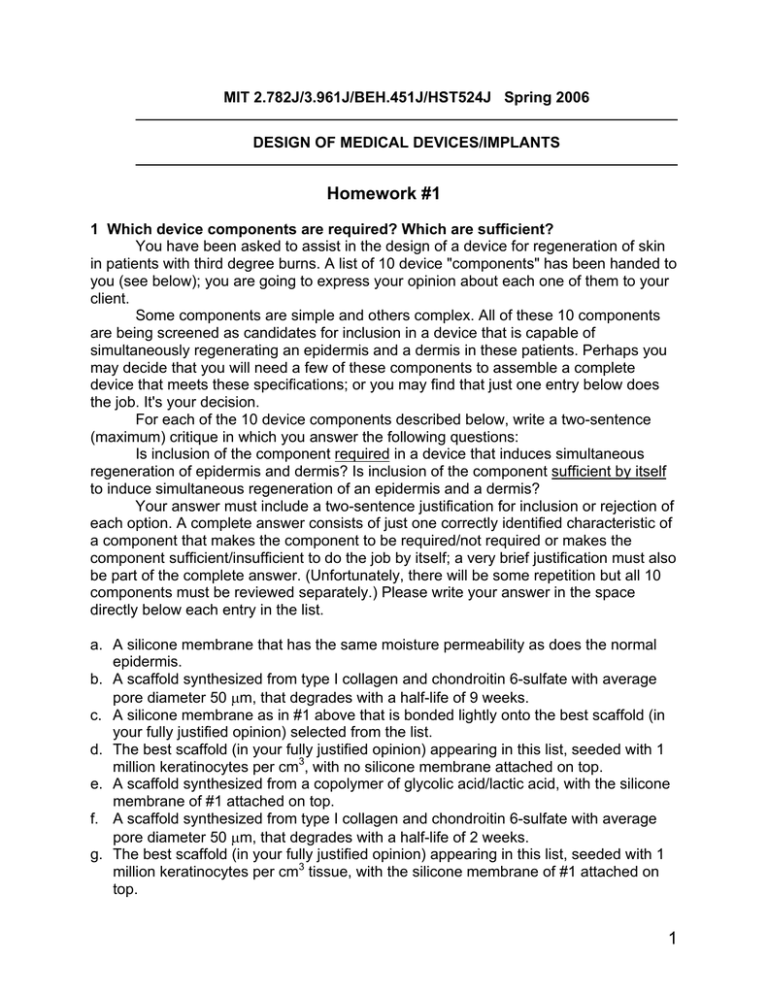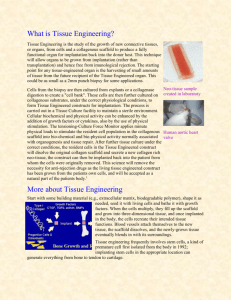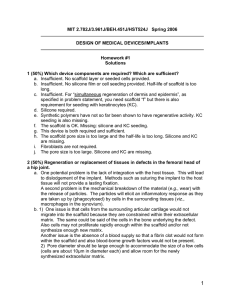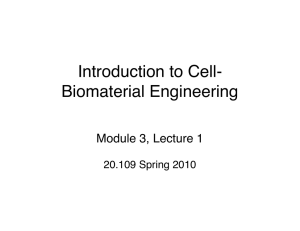Homework #1
advertisement

MIT 2.782J/3.961J/BEH.451J/HST524J Spring 2006 DESIGN OF MEDICAL DEVICES/IMPLANTS Homework #1 1 Which device components are required? Which are sufficient? You have been asked to assist in the design of a device for regeneration of skin in patients with third degree burns. A list of 10 device "components" has been handed to you (see below); you are going to express your opinion about each one of them to your client. Some components are simple and others complex. All of these 10 components are being screened as candidates for inclusion in a device that is capable of simultaneously regenerating an epidermis and a dermis in these patients. Perhaps you may decide that you will need a few of these components to assemble a complete device that meets these specifications; or you may find that just one entry below does the job. It's your decision. For each of the 10 device components described below, write a two-sentence (maximum) critique in which you answer the following questions: Is inclusion of the component required in a device that induces simultaneous regeneration of epidermis and dermis? Is inclusion of the component sufficient by itself to induce simultaneous regeneration of an epidermis and a dermis? Your answer must include a two-sentence justification for inclusion or rejection of each option. A complete answer consists of just one correctly identified characteristic of a component that makes the component to be required/not required or makes the component sufficient/insufficient to do the job by itself; a very brief justification must also be part of the complete answer. (Unfortunately, there will be some repetition but all 10 components must be reviewed separately.) Please write your answer in the space directly below each entry in the list. a. A silicone membrane that has the same moisture permeability as does the normal epidermis. b. A scaffold synthesized from type I collagen and chondroitin 6-sulfate with average pore diameter 50 µm, that degrades with a half-life of 9 weeks. c. A silicone membrane as in #1 above that is bonded lightly onto the best scaffold (in your fully justified opinion) selected from the list. d. The best scaffold (in your fully justified opinion) appearing in this list, seeded with 1 million keratinocytes per cm3, with no silicone membrane attached on top. e. A scaffold synthesized from a copolymer of glycolic acid/lactic acid, with the silicone membrane of #1 attached on top. f. A scaffold synthesized from type I collagen and chondroitin 6-sulfate with average pore diameter 50 µm, that degrades with a half-life of 2 weeks. g. The best scaffold (in your fully justified opinion) appearing in this list, seeded with 1 million keratinocytes per cm3 tissue, with the silicone membrane of #1 attached on top. 1 h. A scaffold synthesized from type I collagen and chondroitin 6-sulfate with average pore diameter 500 µm, that degrades with a half-life of 9 weeks. i. The best scaffold (in your fully justified opinion) appearing in this list, seeded with 1 million autologous keratinocytes per cm3 and one million autologous fibroblasts per cm3, with the silicone membrane of #1 attached on top. j. A scaffold synthesized from type I collagen and chondroitin 6-sulfate with average pore diameter 500 µm, that degrades with a half-life of 2 weeks. 2 Regeneration or replacement of tissues in defects in the femoral head of a hip joint. You have been hired by a company that is interested in developing products to permanently replace or regenerate tissues in defects in the femoral head. The femoral head (see figure below, left) is comprised of a 4mm thick layer of articular cartilage (of rubber-like consistency) on cancellous bone (of sponge-like architecture)-see figure below, right; ignore the ligament that attaches to the middle of the head. The company has developed 2 novel materials that can be made in non-porous or porous form and made non-absorbable or absorbable (i.e., degrade/dissolve in the body). One of the materials (CAR) can be made to have a compressive stiffness similar to articular cartilage and the other (BON) a stiffness close to bone. The strengths of the materials also compare favorably to the strengths of articular cartilage and bone. The two types of materials can be bonded together and constructs can be produced that are comprised of porous and non-porous layers that are non-absorbable or absorbable. Cartilage Bone Figure by MIT OCW. Figure by MIT OCW. 2 a. The Company would like to first consider the development of a construct to be implanted in a defect of about 5mm in diameter in the cartilage layer only (i.e., defect does penetrate the bone). They want to use a non-porous non-absorbable form of CAR. What are two of the most important issues that need to be addressed? Briefly explain why. b. As an alternative to the approach in “a” the Company would like to investigate a porous form of CAR for the regeneration of articular cartilage. 1) What 2 issues would argue against the use of the porous material alone (i.e., non-cell-seeded) for this application, with respect to the likelihood that the scaffold would become infiltrated by host cells? 2) What pore diameter range would you expect to be best for this application? Briefly explain. 3) Is there an additional surgical procedure that could be performed at the time of placement of the implant that you could propose to increase the likelihood that the scaffold would become infiltrated with host cells? Briefly explain. 4) If you were to use cells grown outside the body to seed the scaffold before implantation what would you propose as the source of the cells? Note the key advantage and the principal disadvantage. 5) Would you propose the use of the non-absorbable or absorbable form of CAR for this application? Briefly explain. c. The company would also like to develop an implant to treat defects that go through the articular cartilage into the underlying bone; consider a defect that is 5mm in diameter and 10mm long. Which material or combination of the Company’s materials would you propose for this application. Explain your selection of material(s). Keep in mind the importance of rationalizing any complexities relative to cost. 3






